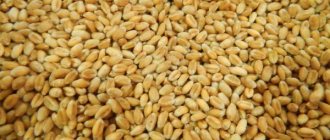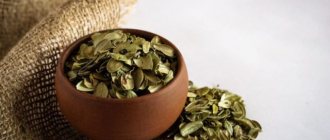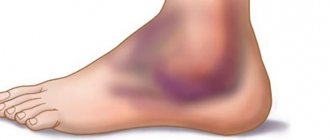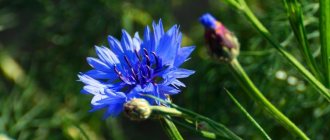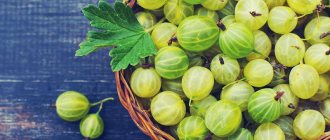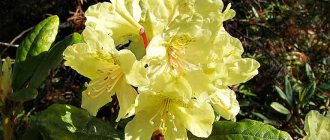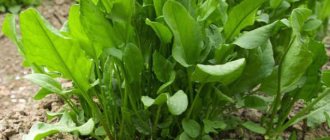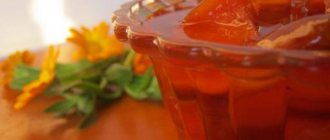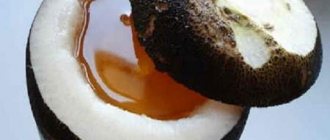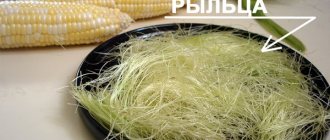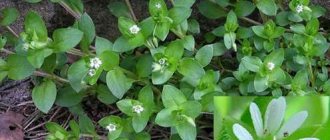Home / Cooking / Ingredients and products
Back
Published: 01/21/2020
Reading time: 9 min
0
2203
4.5 / 5 ( 4 voices)
There are many different spices. Turmeric is one of them. In this article we will tell you what beneficial properties and contraindications turmeric has, recipes using this amazing miracle spice, about the types and medicinal properties of turmeric.
You will learn what turmeric is, what color it comes in. What is the spice used for and how to take it correctly as treatment and prevention for various diseases. Recommendations regarding intake and dosage will be given.
When faced with a choice, which spice should be chosen for a person’s future life, the answer will be this: we must give preference to turmeric. Her homeland is India. Turmeric has been used for treatment in Ayurvedic medicine since 500 BC. e.
The spice has many beneficial qualities. There is an opinion that it has a stronger effect than various medications. It cannot be said that all diseases can be cured with the help of turmeric. But, according to the research results, we can conclude: with its help, you can solve a large number of problems, with minimal (if any) side reactions.
- Appearance
- Composition of turmeric
- Types of Turmeric White Turmeric
- Yellow turmeric
- Red turmeric
- Indian turmeric
- Turmeric curry
- Javanese turmeric
- Turmeric root
- For liver treatment - how to take
- Turmeric for coughs for children - recipe with milk
Appearance
Turmeric is a perennial. It grows up to 1 meter in height. It is characterized by the presence of very long, ovoid leaves. They have pointed tips. The color of the leaves can be dark green. There are also light tones of leaves.
The inflorescences of the plant have yellow-green shades. You can find purple flowers. Only they don't produce seeds. The interesting thing is that turmeric has seeds, and the propagation process occurs through the roots. The main part of the root system is in the form of a tuber. There are a lot of side shoots. Their length is several centimeters.
Photo: what is turmeric and what the plant looks like
Composition of turmeric
The composition of turmeric and its beneficial properties are undeniable. It contains vitamins: group B (B1, B2, B3, B), ascorbic acid. It also contains microelements, in microdoses: iron, phosphorus, iodine and calcium. For example, 100 grams of turmeric contains vitamin B1 in a dosage of 0.15 g. It turns out that a pinch of seasoning contains only a small part of microelements. But turmeric has components that, even in mini-doses, have a healing effect on the human body. We are talking about essential oils and their components: sabinene, borneol, zingiberene, terpene alcohols, phellandrene, curcumin and other components.
Of particular note on this list is curcumin, which gives foods containing it a yellow color. E100 (turmeric), which is a food additive, is made from this ingredient.
In the food industry it has become widespread in the production of products such as mayonnaise and butter. Cheese, margarine, yogurt. Turmeric colors products a pleasant yellow color to give them a beautiful presentation.
Medical professionals have been studying the beneficial properties of turmeric for a long time. They did a lot of scientific research. As a result, it was found that turmeric has a detrimental effect on pathological tumor cells, while it does not affect healthy cells.
It turns out that if you use drugs containing curcumin, growth will not only be stopped, but new malignant tumors will not appear.
History of use in folk medicine
The medicinal properties of turmeric were well known in ancient India, where the name of the plant in Sanskrit sounded like “harirda”. Indian healers used rhizomes to treat all sorts of diseases - from colds to leprosy, and also as an effective antidote for the bites of poisonous snakes and spiders.
Written sources contain recipes for potions used to treat skin diseases and disorders of the digestive system. The antitoxic properties of turmeric and its ability to cleanse the body were especially valued in ancient times.
Buy turmeric (powder) on our website
The oriental spice, which gives dishes an appetizing yellow color and has healing properties, quickly attracted the attention of Europeans, and in the Middle Ages the plant came to Europe, enjoying increased attention from traditional medicine and culinary experts since then.
Modern Indian medicine continues to study the effects of turmeric; At the same time, the amazing effectiveness of the recipes found in ancient Indian treatises is noted. Thus, the positive effect of turmeric preparations on cancer and the treatment of corneal ulcers has been scientifically proven.
Interesting fact
As an effective antidote, turmeric was in great demand among the aristocrats of Europe during the dark Middle Ages, full of intrigue and conspiracies.
Types of turmeric
Approximately 40 species of this plant are known to exist. It should be noted that only some are used for making spices.
The yellow powder that is used by people in the preparation of various dishes is made from the roots of Curcuma longa.
There are also types of plants that are used to prepare alcoholic beverages. Turmeric comes in different colors, let’s find out in what form you can find this amazingly healthy spice on store shelves.
White turmeric
Cedoaria or white turmeric is considered one of the plant species discussed in the article. The roots of the plant are crushed and used for cooking and medicine. They taste bitter and scalding, but have a unique aroma. White turmeric is used by doctors in India.
With the help of spices, coughs, diabetes, anemia and other diseases are treated. Another spice made from this plant is used as an analgesic and choleretic agent. And white turmeric oil has found use in perfumery.
Photo: white turmeric root
Yellow turmeric
This is a spice. It looks like powder. It is obtained when the long or white turmeric root has been dried and then ground.
Often used when you need to prepare sauce, omelet, salad, stew. Used to give pasta or pilaf a richer taste.
Red turmeric
Turmeric longa has different types. Among them there are varieties whose tubers are red in color. When they are crushed, it turns out “two in one”: both a spice and a natural dye.
Residents of Asia often use red turmeric as a seasoning when preparing dishes.
Photo: yellow and red turmeric in powder form
Indian turmeric
The spice, which many call “saffron from India,” can not only give dishes a sophisticated taste, but it is also used as a natural antibiotic.
In the traditional Indian medicine system Ayurveda, this spice is described as one that is endowed with many positive characteristics. In particular, turmeric is used for preventive purposes and for the treatment of atherosclerosis.
Photo: Saffron or Indian turmeric
Turmeric curry
A mixture is made based on turmeric. They called it curry. If we consider the entire curry mixture, then this spice usually ranges from 20 to 30%. In addition to turmeric, the composition contains from 7 to 20 different ingredients.
Curry leaf, which has been ground into powder, is another essential ingredient of this spice. In those countries where the spice does not grow, Greek fenugreek is used instead. Other ingredients in curry include red pepper and coriander.
Curry is used to add flavor and a beautiful color to dishes. For example, when preparing meat and poultry, rice and vegetable dishes.
Photo: What curry seasoning looks like
Javanese turmeric
Long turmeric is smaller than this plant. In addition to this difference, the composition of the tubers of these plants is also different. Turmeric is more used as a spice. Javanese has found wide application when making medicines.
Thus, drugs made on the basis of this culture effectively treat diseases of the gallbladder and liver. Anti-inflammatory drugs are also made from Java turmeric.
Turmeric root
The root of this part of the plant is successfully used in the manufacture of all kinds of medicines. It has also found its application in cosmetology. The tuberous roots became the basis for creating the seasoning. Turmeric root is sold in tablets, capsules and powders.
Turmeric root powder has been successfully used to treat hemorrhoids and ulcers. It will both disinfect the wound and prevent harmful microorganisms from entering the body.
Turmeric root can be sold in pharmacies as an infusion of vodka. This remedy can be used in the form of compresses to relieve muscle pain due to injuries, bruises, and sprains. If your throat hurts, to relieve swelling and irritation, gargle with vodka infusion of turmeric.
What is turmeric?
This plant is native to India.
A spice is made from its roots and leaves, which is popular not only in southeastern countries, but also throughout the world.
Curcuma longa, Curcuma domestica, Curcuma cultivars, or turmeric, yellow ginger is a perennial herbaceous plant, a species of the genus Curcuma of the Zingiberaceae family.
Due to the fact that turmeric has strong coloring properties (it gives a pleasant yellowish-golden color), it is quite widely used in cooking, in the food industry, in the manufacture of textiles, and in the production of cosmetics.
A significant “advantage” of this spice is that it is relatively inexpensive, so quite often the expensive spice saffron is replaced with turmeric.
That is why turmeric is called “Indian saffron”. You've probably come across this name in some recipes. If so, then know that Indian saffron and turmeric are the same thing.
The combination of the strongest healing, coloring and amazing taste and aromatic properties, with the perfect availability of this spice for all segments of the population anywhere in the world, makes turmeric truly ideal!
Types of turmeric
In total, more than 40 types of turmeric are known. For food and medicinal use, 3 main varieties of spices are most often grown:
- “Turmeric longa” or “domestic” is a bright yellow powder that gives food an appetizing golden hue.
- “Aromatic turmeric” is a more expensive variety, which is more often used to give dishes a pronounced aroma. Meat, baked goods, drinks and various confectionery products - this type of spice will diversify them.
- “Turmeric cyodaria” - this type of spice is cut into pieces to make tinctures and liqueurs.
There are also various variations of fresh and dried leaves on the shelves in India, which can be added to dishes and teas.
Where does it grow?
The spice turmeric is most common in Indochina. In the 1st century AD, the spice came to Ancient Greece, from where it spread throughout Europe over the next 400 years and came to China. It was there that breeders developed the most delicious and expensive varieties of culinary spice.
Today, the perennial plant is cultivated in the South-East of India, on the island. Java, in China, the Philippines, Jamaica and even in South America, where it has become an integral part of spicy Mexican cuisine.
Taste and smell
Turmeric has a bright, volatile aroma, which becomes subtle and unobtrusive when cooked. The flavor bouquet of different varieties is different. “Homemade” food is better suited for cooking due to its light spicy taste. The “fragrant” spice is more applicable in confectionery and cosmetology. As for the “ceodary”, you can’t eat it at all. The pungent taste and camphorous aroma of the root make it suitable only for alcoholic beverages.
Chemical composition and beneficial properties of turmeric
Turmeric is used in food, for medicinal purposes, as a dye, in cosmetology, and also in Ayurveda, as one of the medicines.
It contains iron, B vitamins, magnesium and calcium.
But the main benefits for beauty and health are achieved due to the active ingredient “curcumin”, which gives the powder its bright color.
Curcumin is a strong antioxidant, healing and choleretic agent that can inhibit the growth of bacteria and strengthen the body's resistance during periods of infections and during chemotherapy.
Its anti-inflammatory properties allow the spice to be used to relieve a wide range of diseases:
- including ulcerative colitis
- gynecological inflammations
- for oral problems
- inflammatory processes in joints with arthritis
- skin inflammation, even if it is “just” a cosmetic problem.
Moreover, without any of the toxicity of conventional drugs.
Curcumin also increases the activity of intestinal flora, improves digestion, reduces cravings for sweets and lowers cholesterol levels, so it is an excellent weight loss aid for people suffering from diabetes and cardiovascular diseases.
Medicinal and beneficial properties of turmeric
Has an anti-inflammatory effect. This is what the seasoning is mainly valued for. Curcuminoids tend to relieve inflammation in the body. They fight inflammatory agents with cytokines. The effect of curcumin is compared with some anti-inflammatory drugs that do not have a negative effect on the mucous membranes and stomach.
In addition, the anti-inflammatory effects of curcumin occur in conjunction with the body's natural response to inflammation. But medications work differently.
When the anti-inflammatory effect of curcumin was studied in the laboratory, experts concluded that it was the same as known non-steroidal drugs for inflammation.
- It is an excellent pain reliever. At the same time, both the pain and the inflammation itself go away. As soon as one symptom goes away, the other will go away too.
- Has rejuvenating properties. This is a loud statement. It has only been proven that curcumin works well against various compounds that have accumulated in the body and lead to early aging and destruction of brain cells and tissues.
- It is a powerful antioxidant and a means of prolonging youth.
- Stops bleeding and helps wounds heal faster. Helps when the process of blood clotting occurs. Normalizes this process in the body.
- Has antimicrobial properties. Effectively fights fungal infections, viruses, parasites. It turns out that curcumin is a natural antibiotic. It protects cells from being attacked by pathogens.
- Has hepatoprotective properties. Curcuminoids have a positive effect on the gallbladder and liver.
- They have a choleretic effect. They normalize the functioning of the gallbladder and help liver cells recover.
- If you have diseases of the pancreas, stomach, ulcers, gastritis, the use of curcumin will benefit the body.
- Activates collagen production, helps tissues and blood vessels recover.
Curcumin has excellent properties - it suppresses and eliminates cancer cells that form in the stomach, esophagus, pancreas, prostate and mammary glands. A large amount of research has been carried out. Based on their results, many anticancer agents containing curcuminoids have been created.
Research is still being carried out. Curcumin has been proven to be effective in fighting cancer. Destroys cancer cells before they begin to form tumors. If growths occur that can become cancerous, a person should start consuming curcumin daily.
If you have joint diseases (arthritis, arthrosis, autoimmune disease), curcumin can be considered as a remedy. Curcumin has a well-known medicinal property - it can suppress inflammatory reactions in the joints.
If you have some autoimmune diseases, curcumin will help. It will reduce and stabilize inflammation processes in tissues.
Curcumin is the strongest antioxidant with a high index. It prevents the process of acidification in tissues from starting, and prevents the harmful effects of free radicals on DNA cells and the body.
Author:
womanss.ru
Still have questions? Ask them to the author in the comments!
auto RU
Has a positive effect on blood vessels. Helps stabilize blood pressure. The process of development of atherosclerosis slows down.
If you have cardiovascular diseases, experts advise including curcumin in your diet. Research is being carried out in the medical field. Based on their results, it becomes clear that turmeric is in demand.
The future is behind her. It is increasingly used for the manufacture of drugs for the treatment of heart and vascular diseases. It has statin properties. Doctors prescribe them for these diseases. Statins are drugs that reduce and normalize cholesterol levels in the blood.
Helps thin the blood. Prevents blood clots from forming.
These properties are pronounced. To avoid bleeding, doctors advise not to use curcumin along with other anticoagulant drugs.
Since curcumin affects the production of insulin, it stabilizes blood sugar.
Athletes value curcumin for its anti-catabolic effects. Having a positive effect on the body, it prevents tissue destruction and slows down these processes.
This fact is important especially when it comes to muscle tissue. Reduces inflammation and the risk of tissue damage during training. Helps the body recover after sports.
Has a weight loss effect. A person does not feel the desire to eat something sweet and fatty. Reduces the amount of fatty tissue in the body.
Tea against cancer
Everyone knows the healing properties of antioxidants, natural substances that prevent the development of cancer cells. People fighting cancer are looking for foods rich in these ingredients. These include turmeric, ginger, lemon, honey, which are especially effective in treating ovarian, bladder, and lung cancer.
An article published in the British Journal of Cancer confirmed that these natural products affect the growth of tumors while stimulating and restoring normal functioning of healthy cells.
To prevent and promote cancer treatment, a drink made from coconut milk, cinnamon, ginger, and turmeric is recommended.
- 1 cup coconut milk (you can replace it with the same amount of water with 1 tsp coconut oil).
- 1/2 tsp each yellow spice, cinnamon, ginger powder.
- 1 tsp honey
Article for you:
How to lower blood cholesterol with clover
You can add to tea with turmeric and ginger:
- 1 piece of lemon.
- 1/2 tsp. nutmeg.
- 5 mint leaves.
- a pinch of black or cayenne pepper.
Place coconut milk (or coconut oil water) in a small saucepan. Thanks to fats, turmeric will be better absorbed. Add remaining ingredients. Bring to a boil, cook for about 10 minutes. Cool slightly, add honey. Drink the drink warm. Consume daily. Course – 2 months, break – 2 weeks.
Anti-cancer mixture
A mixture of turmeric (1/4 tsp), black pepper (pinch), olive oil (1/2 tsp) can prevent the development of tumors and promote treatment. Take the mixture daily. You can add it to food, but not during heat treatment, but at the end of cooking.
Contraindications for use
Since turmeric has such a powerful effect, there is a category of people who need to use it with caution or avoid it altogether.
If a person has been prescribed any medications by a doctor, then dishes containing turmeric should not be eaten. Otherwise, the picture of the disease will be distorted.
Patients diagnosed with pancreatitis, cholelithiasis, hepatitis, gastritis with high acidity should not consume turmeric. This is due to the fact that spices tend to activate the functioning of the pancreas and increase the production of gastric juice and bile.
Pregnant women should consume turmeric in small doses. This is due to the fact that spice can provoke increased uterine tone, and in the future the baby may develop diathesis.
Of course, turmeric is considered a healthy and aromatic product with an original taste. However, experts recommend consuming 5 to 8 grams per day. Not more. If you have any doubts about whether a spice will cause harm (or not), it is advisable to consult a doctor.
Drinks for a slim figure
Losing weight is an issue that is relevant not only for women, but also for men. One of the natural fat burning aids is turmeric root. Below are some recipes for weight loss. Before using them, consider the pros and cons of taking them: risk of allergies, hypersensitivity, lactose intolerance...
"Golden Milk"
First prepare the yellow spice paste:
- Mix in 1/4 cup yellow spice.
- 1/2 tsp. ground black pepper.
- 1/2 glass of water.
- Mix the ingredients in a saucepan over low heat.
- Cool the resulting paste.
For golden milk, use any type of milk (almond, coconut, cow)
- 1/2 tsp. cooked pasta.
- Coconut oil.
- Honey.
- Pour milk and coconut oil over pasta and heat over low heat.
- Don't boil! Then add honey.
Due to its relaxing and calming effects, it is better to drink the spice with milk and honey at night. The benefits and harms of the drink depend on the tolerance of the components, so before drinking, make sure that you are not prone to allergies!
In addition to its benefits for weight loss, turmeric with milk also provides the body with antiseptic and antibacterial substances, which are important for night regeneration of the body.
Slimming Tea
It's easy to make tea:
- 1/2 tsp. spices pour 250 ml of boiling water.
- Add a pinch of black pepper.
- Drink 1-2 times a day 15 minutes before meals.
Article for you:
Treatment of stomatitis with brilliant green
The course of admission is 4-6 weeks in a row.
Ginger, cayenne pepper and kefir
The next effective recipe for weight loss is a combination of turmeric with kefir and ginger.
You need:
- 1 tsp golden spice.
- 2 tsp honey
- 1/2 tsp. cayenne pepper.
- 2 cm chopped ginger root.
- 250 ml kefir (2.5% fat).
- Mix all ingredients.
Drink 2 times a day:
- turmeric with kefir at night will ensure body regeneration;
- Breakfast mixture will give you energy.
Take the beneficial remedy for a month (at least).
Healthy coffee
Yes, your favorite drink will help you lose weight! It is enough to add a pinch of yellow spice and black pepper to it during cooking. In addition to a slim figure, coffee with turmeric and pepper will improve digestion and eliminate flatulence.
Important! Please note the contraindications for drinking healthy coffee. These include high blood pressure and heart disease.
Recipes for using turmeric for medicinal purposes
For liver treatment - how to take
It is advisable that turmeric be present in the diet as a seasoning for dishes. But there are other options for using spices when you need to treat diseases.
- Used in its pure form.
Take 0.5 tsp. powder (without additives), in the morning, before breakfast. Drink 250 g of water.
- In combination with celandine.
The celandine herb is ground to a powdery state. Take 1 tsp. turmeric powder and celandine. Pour 250 g of boiling water. Drink 200 ml of the product, warm, 3 times a day. The treatment course is one month.
- Using milk and honey.
Warm milk is poured into a glass. Add 1 spoon of turmeric paste there. If desired, add honey. Drink on an empty stomach.
How to make medicinal turmeric paste:
- pour 250 ml of water into a container,
- boil,
- add turmeric (2 tbsp.),
- boil for 10 minutes.
The paste has a shelf life of approximately 30 days. Just the place should be cool.
- Using milk and cashews.
You will need 250 ml of milk. Add 1 tsp to it. turmeric and 2 tbsp. cashew nuts. Beat the composition with a blender. Drink before meals. The course of treatment is 20 days.
- A spicy composition that cleanses the body.
Water is boiled in a container. Add: turmeric and ground ginger (1 tsp each). Cinnamon (3/4 tsp) and black pepper (pinch) are also added there. After adding the ingredients, the drink is removed from the stove. When the drink becomes warm, add coconut milk (70 ml), honey (1 tsp). The product is used when it is necessary to treat the liver, or for prevention.
Attention! No products (or dishes) containing turmeric should be consumed if a person is taking medications.
Treatment of psoriasis with turmeric
Psoriasis is considered to be a skin disease. The disease affects not only the skin. It can negatively affect the condition of internal organs and joints. If a person is not provided with medical assistance in a timely manner, he may become disabled. Spices alone cannot fight this disease. This requires a complex of therapeutic measures, consisting of the use of medication, physiotherapeutic procedures, and a special diet.
Attention! The use of alternative medicine methods must be agreed with a specialist.
Turmeric contains active substances that have anti-inflammatory, antiseptic, and immunomodulatory effects. That is why it is often used in the treatment of psoriasis. The important thing is that the spice has cleansing properties.
The spice has a positive effect on the intestines and liver. It helps remove toxic substances from the body.
This makes it possible to overcome psoriasis when a complex effect is exerted on the body. The result of the treatment will be supported by the fact that the spice can normalize the activity of the immune system.
Turmeric has helped a large number of people who suffered from psoriasis. It was added to juice and cocktail. When preparing dishes, this spice was added as a seasoning. To finally get rid of the signs of psoriasis, these measures will not be enough.
Turmeric can be purchased as a mass in powder form. It is often sold in the spice department. If you visit a pharmacy, you can see the availability of:
- Tablets. In order for the purchase to be “correct”, you need to be careful and make sure that the product contains at least 95% turmeric extract. You should take 2-3 grams of tablets per day. This dose is considered standard, recommended for daily use. It is advisable to also consult a doctor. In each specific case, only a specialist should determine the dosage.
- Turmeric tincture. They can be alcohol or water based. They are taken orally. Before taking, you need to dilute the drops with water (a small amount of water is needed). Take the tincture three times a day, according to the instructions for use, and following the doctor’s recommendations.
- You can also prepare your own turmeric ointment at home. For external use, it is not difficult to make a mass in the form of a paste, according to this recipe: Take turmeric (1/4 tsp). Add a small amount of water. Stir to obtain the desired consistency. This paste is applied to diseased areas of the skin. They bandage it. It is advisable to do this procedure before going to bed so that the remedy takes effect overnight. In the morning, wash off with warm water. The patient will notice improvements within 3-5 days. You can also use turmeric to make compresses. It must be mixed with aloe juice. This method is very popular because aloe has healing and antiseptic effects.
The results of using spices to treat psoriasis will be as follows:
- itching will bother the patient less;
- swelling will decrease;
- local redness and plaques will go away.
You should not hope for instant results from using turmeric if the spice is only present in dishes. Therapy (whatever it may be) has a positive effect only when a set of measures is applied.
Turmeric for diabetes
Turmeric is not always combined with type 2 diabetes. It is for this reason that you need to consult a doctor. Since the spice has a pronounced taste, it affects the normal functioning of the gastrointestinal tract. Type 2 diabetes can lead to gastritis, constipation, and hemorrhoids.
It is important that only a doctor determines what the dose of turmeric should be. If there are no contraindications, consuming the spice will improve your blood condition
The production of red blood cells will increase, and platelets will not stick together as intensively, but this process leads to the appearance of plaques.
When you have type 2 diabetes, the process by which the blood becomes thinner is very important. The patient will feel better.
Diabetics are recommended to take turmeric in the following daily dosage:
- 2 grams of root, cut into pieces;
- 1 to 3 grams of root (powder).
- 500 mg powder (you can buy it in one of the stores).
Attention! To enhance the healing effect, black pepper or oil is added to turmeric.
How should a patient with type 2 diabetes take turmeric? Since the spice is very popular, there are a large number of recipes. If a person has diabetes, then he should consume the seasoning in limited doses in drinks and dishes.
- Healing tea with turmeric for diabetes
Ingredients: 3 tablespoons (full) of black loose leaf tea, cinnamon (1/4 teaspoon), one and a half tablespoons of turmeric (not heaped), ginger root (3 small pieces).
The composition is poured with water (not boiling, but hot). Once the drink has cooled, it is ready to drink. If desired, add honey.
- Another drink has gained popularity, with the addition of turmeric, which is easy to prepare at home.
Cow's milk is poured into a glass. Add spice (30 g). Drink twice a day.
- Healing hour with mint and ginger
Mint, ginger, lemon zest should be finely chopped. Add turmeric (2 tablespoons, without a slide). The components are poured with hot (not boiling) water. Drink small portions throughout the day.
- Before eating, take turmeric in its pure form (1/3 teaspoon) and simply wash it down with water.
- Turmeric + mumiyo for diabetes is also an effective remedy. You need to crush 1 mummy tablet. Mix with turmeric powder (50 mg). Drink the product twice a day, 1 tsp.
Recipes and techniques for using turmeric as a cholesterol remedy
So far, no clearly defined dosage of using spices has been developed to treat high levels of lipoprotein in the blood. Recipes can be found in various sources. If you study the reviews, these recipes turned out to be very effective in practice when it was necessary to treat hypercholesterolemia, or to engage in prevention, with the help of turmeric.
If we analyze the results of all studies. Which were carried out by independent organizations, we can conclude: the dosage of the spice in recipes will depend on the composition of the product itself, on the condition of the person suffering from high cholesterol.
Methods for using turmeric as a medicine for high cholesterol are presented below.
To reduce cholesterol levels in the body, it is advisable to use the powder in its pure form, tea with turmeric and drink Golden Milk. The table provides recommendations for the dosage of turmeric powder and for preparing medicinal tea. And also how to properly prepare Golden Milk.
According to reader reviews, if you use these recipes, you can lower your cholesterol levels and the person will begin to feel better.
For high blood pressure
For hypertension, in order to reduce blood pressure, you need to take this remedy. Combine the ingredients: turmeric (1 tsp), poppy seeds (1 tbsp), sesame seeds (1.5 grams), flax seed (2 g), honey (10 ml). Blend in a blender to obtain a homogeneous mass. Make 3-5 balls from it. Use them throughout the day. In the first stages of hypertension, you need to eat 1 ball per day. They eat it right away. Drink with water.
If your blood pressure is high due to excess weight, sugar should be eliminated. Instead, you should eat spicy honey. Mix honey (50g) and spice (1 tbsp). You should eat 2 to 3 teaspoons of the product per day. You can drink it with tea or eat it with dessert.
Turmeric is an effective folk remedy if a person has hypertension. You just need to start treatment only after consulting a doctor. Only a specialist will prescribe the dosage in combination with treatment.
Uses of turmeric
The main use of turmeric is cooking. The seasoning is also widely used in folk medicine, and curcumin is officially included in some medications.
Turmeric root juice is a dietary supplement. It is obtained by cold pressing. To obtain a liter of juice, 12 kg of rhizomes are required.
The juice is taken a teaspoon orally to prevent cancer, heart attacks, and strokes. The juice also has the property of healing abrasions and cuts.
You can buy turmeric powder in capsules in pharmacies. This is also a dietary supplement that is taken for preventive purposes. The drug is indicated for cardiovascular diseases and chronic bronchitis.
The beneficial properties of the spice are best demonstrated in combination with ground black pepper. Curcumin is poorly absorbed in the intestines, and piperine, which is found in black pepper, improves the absorption process.
In cooking
Ground turmeric is used to add flavor and aroma to various dishes. The seasoning is especially popular in Asian countries. Turmeric goes best with meat dishes such as pork, chicken, and beef.
Add spice to rice dishes. One of the popular Indian dishes is chicken with rice and curry, which includes turmeric. The spice gives vegetable salads and stews a spicy aroma.
Various sauces are prepared with the addition of spices. Black pepper helps highlight the spicy aroma of the seasoning. It adds heat to sauces and marinades, and turmeric gives them a pleasant yellow color.
The optimal ratio is three parts turmeric, one part black pepper. In this combination, the taste qualities of the spices are maximized, and the beneficial properties are also significantly enhanced.
Add the spice 5-10 minutes before the end of cooking. If you add it at the beginning, almost all the beneficial substances are destroyed under the influence of high temperature, and the healing properties are lost.
Chopped fresh root of the plant is added to sauces and rubbed onto meat before baking. A healthy drink is prepared with fresh root. Grind the roots of turmeric and ginger and add water. Add lemon juice and mint.
There are no spices identical to turmeric. It cannot be completely replaced by anything. Turmeric and saffron are similar in color. Therefore, saffron can be used to give a yellow color to dishes. You can also use curry because this spice contains turmeric.
View this post on Instagram
Posted by Handmade brooches (@brooch_by_elis) Sep 2, 2021 at 2:33 PDT
In folk medicine
The seasoning is used to treat many diseases. It is used not as an independent medicine, but in combination with other methods.
- Digestive system. Turmeric improves digestion and restores normal intestinal microflora. Serves as a prevention of inflammatory diseases of the gastrointestinal tract. If gastritis is in the acute stage or peptic ulcer, turmeric should not be taken.
- For arthritis, arthrosis, after injuries. Due to its anti-inflammatory and analgesic properties, the seasoning is used as compresses or wraps for sore joints. Taking golden milk internally strengthens bone tissue and prevents the development of osteoporosis.
- For blood diseases. One of the beneficial properties of the spice is the prevention and treatment of anemia. Curcumin can thin the blood, so it is useful for people with a tendency to form blood clots. Consumption of seasoning reduces the risk of heart attacks and strokes.
- Improvement of the nervous system. Turmeric has the property of improving memory and stimulating cognitive function. Curcumin stimulates the production of serotonin, the hormone of joy. Regular use of the spice improves mood and improves emotional background.
- Colds. Turmeric is taken for colds to relieve symptoms and speed up recovery. The plant helps with coughs, removes phlegm, and makes breathing easier.
- Oral diseases. The anti-inflammatory and antibacterial properties of turmeric have proven useful for caries, stomatitis, gingivitis, and periodontitis. Rinsing your mouth with diluted spice cleanses plaque from teeth and gives freshness to your breath.
- Fresh roots of the plant are used against parasites. They are crushed, poured with hot water, and the infusion is drunk.
- In diabetes mellitus, curcumin regulates blood glucose levels.
Watch Elena Malysheva’s program about using spices for health:
For medicinal purposes, turmeric is prepared in several ways. If you simply add it to food, only preventive properties are realized.
- Infusion. The roots of the plant are grated and filled with hot water. After two hours, filter and drink a glass in the morning. You can drink it with lemon juice and honey.
- Golden paste is prepared for future use and stored in the refrigerator. Pour a glass of water into a saucepan and add 50 grams of turmeric powder. Cook over low heat until thickened. Pour in 100 ml of vegetable oil and mix. Add 10 grams of black pepper and cook until paste-like. The finished paste is eaten a teaspoon with honey, added to food, and used to prepare golden milk.
- Golden milk. Heat a glass of milk and stir a teaspoon of golden paste into it. Drink a glass in the morning or evening.
The beneficial properties of the spice are realized when used externally. Compresses and wraps are indicated for inflammatory joint diseases. The powder is mixed with badger fat and slightly heated. Apply to sore joints and cover with a woolen cloth.
We recommend watching a story about the simple use of spices:
In cosmetology and weight loss
Turmeric is one of the most effective spices used for weight loss. Curcumin speeds up metabolism and cleanses the body of toxins. Stimulates lymphatic drainage, blood circulation, removes excess fluid. All these properties allow you to get rid of excess weight.
- Kefir with turmeric. Stir a pinch of seasoning in a glass of kefir. Drink at night for a month.
- Brew a glass of strong tea, add a spoonful of turmeric. Mix with a glass of kefir and a spoon of honey. Drink a glass in the morning for a month.
- 100 grams of liquid honey is mixed with a bag of turmeric. Heat it up and apply the warm mass to the thighs, buttocks, and stomach. Wrap the body with plastic wrap. After 3-4 hours, take a warm shower.
The composition of the spice makes it beneficial for the skin. Her condition is improving and her skin diseases are being cured. The content of vitamins A and E helps reduce the number of wrinkles and prevents premature aging of the skin. Curcumin is effective in the treatment of psoriasis, eczema, and acne.
- Mask for normal skin. Egg yolk is mixed with a pinch of turmeric and a spoonful of honey. Apply the mixture to the skin and wash off after 15 minutes.
- Acne mask. Lightly beat the egg white, add aloe leaf juice and a pinch of turmeric. Apply the mixture to problem areas of the skin. When the mask dries, wash off with warm water.
- Mask for mature skin. A spoonful of olive oil is mixed with a spoonful of cream and a pinch of turmeric. Apply the mixture to the skin. Wash off after 20 minutes.
- Hair Mask. Turmeric powder is mixed with mustard powder and egg yolk. Rub into the scalp and wash off after half an hour.
Turmeric is used to whiten teeth enamel. A spoonful of powder is diluted with water to make a paste. Brush your teeth with this paste, then leave it on the enamel for 2 minutes. Rinse your mouth with water.
Note the recipe for a universal mask:
At home
In addition to its beneficial properties, turmeric has one unpleasant effect. This is a very strong and durable dye. It is almost impossible to remove stains from kitchen surfaces, and even more so from clothes.
A fresh stain can be sprinkled with salt and then wiped with a cloth moistened with vegetable oil. Old stains are removed using oxygen bleaches. You can remove stains from white clothes by soaking the item in white.
Is it possible to give turmeric to children?
Only if the child is 6 years old can the spice be used for medicinal purposes. Young children should not be given medications that contain this plant.
Important! If used incorrectly or given too much, abdominal pain or diarrhea will occur.
There are exceptions when children under 2 years of age are allowed to take the drug. Only this - under the supervision of a doctor.
Infants and those under 2 years of age are prohibited from giving turmeric in any form, for medicinal purposes, or for coughs.
Doctors advise pregnant women to be careful when consuming turmeric. It contains many elements that can cause allergic reactions in both the mother and the unborn child.
It is advisable to consult a specialist, and only then begin the treatment process.
It is impossible for several drugs to be used simultaneously during the treatment process. One recipe has been selected, which means that only it should be used. When it becomes noticeable that the drug is not producing results, treatment is stopped. Consult a doctor. They select another remedy.
If the use of turmeric was incorrect, or the dosage was exceeded, this will lead to the following problems:
- hair will begin to fall out;
- constipation will occur;
- the pressure will drop;
- heartburn will begin;
- Your blood sugar will drop.
Turmeric for coughs for children - recipe with milk
This recipe is the most popular. It is often used if a child has a cough. You need to make a mixture: turmeric + honey + milk. First, the spice is mixed in a 1:1 ratio with natural honey. To make one serving of the healing product, 1 teaspoon of each component will be enough.
Boil 250 ml cow's milk. Let cool. Then add the honey mixture. Stir until the liquid acquires a uniform golden hue and begins to emit a pleasant aroma.
It is advisable to give this drink to your child before bedtime. Usually, the baby does not drink the entire glass at one time. Then you need to divide the liquid by 2 times. Place the rest on the refrigerator shelf. Give the product warm to children
As a rule, immediately after taking the medicine, the child begins to cough. The next day you need to give your baby the drink again before bed.
Health benefits and harms of turmeric
Experts have long noticed that turmeric has a good effect on the body, bringing it great benefits with the following properties:
- Purifies the blood, prevents vascular atherosclerosis, removes cholesterol.
- Normalizes digestion, maintains the correct composition of microflora in the intestines.
- Cleanses the liver of toxins.
- Helps get rid of constipation.
- Helps in the treatment of acute respiratory infections, sore throat, tonsillitis, cough.
- Reduces stomach acidity.
- Helps heal wounds and abrasions, bruises, relieves inflammation.
- Has choleretic properties.
- Strengthens the myocardium.
- Helps strengthen the immune system.
- Reduces blood glucose levels in diabetes mellitus.
- Relieves pain and inflammation in arthritis, arthrosis and rheumatism.
- Helps fight cancer as it is a powerful antioxidant.
- Helps with weight loss.
- Stimulates metabolic processes.
- Useful for psoriasis, eczema and other skin diseases, especially in the acute stage, because it provokes rapid healing of wounds.
- Soothes headaches and migraines.
Turmeric has many beneficial qualities, but the powder also has disadvantages. It can cause harm to the body, so you need to know for whom and in what cases it is better not to use this seasoning.
The tasty seasoning has the following contraindications:
- Carrying a child and breastfeeding due to the risk of developing allergies in both mother and baby. For the same reasons, children under 5 years old should not use turmeric.
- For people suffering or suspected of nephritis and urolithiasis, pancreatitis, stomach ulcers, hepatitis, chronic gastrointestinal diseases - turmeric causes exacerbation and aggravates the course of chronic diseases.
- The simultaneous use of medications that are incompatible with the seasoning, for example, for diabetes, can be harmful to health.
- Having tonic properties, it can create problems with falling asleep if the seasoning is consumed in the evening.
- Presence of stones in the gall bladder.
- Poor blood clotting - turmeric can thin the blood even more.
- Individual intolerance.
When you decide to use turmeric as a health booster or to treat diseases, you should consult your doctor. If nausea, diarrhea and other unfavorable symptoms occur after consuming it, then the seasoning should be discarded.
Medicinal properties of turmeric
Turmeric has healing effects on many different diseases. It helps in the treatment of important human organs, because it has the following medicinal properties:
- anti-inflammatory;
- antiviral;
- bactericidal;
- antioxidant;
- antiseptic;
- regenerating;
- choleretic;
- antiparasitic.
The properties of turmeric are well known in the form of neutralization and rapid removal of toxins of any nature - chemical and biological - from blood cells, liver, and kidneys. The spice can be used for medicinal purposes to restore the liver, because it helps to activate regenerative processes in its cells.
How to take turmeric for a cold
If a person has a cold or has one of the respiratory diseases, turmeric will help him. What to do? Brew the spice (0.5 tsp) with boiling water (125 ml). Mix thoroughly. Cool to approximately 36 degrees. Add honey (1 tsp). Let the drink brew for about five minutes. The product can be used. On this day, drink liquid 2 or 3 more times.
If you need to treat tonsillitis or pharyngitis, you need to take salt and turmeric powder (1 pinch each). Dissolve them in 0.5 cup of warm boiled water. You should gargle with this turmeric solution 5 to 6 times a day. You must remember to perform the procedure immediately after waking up and before going to bed.
If you have bronchitis, catarrh of the upper respiratory tract, cough, inhale the smoke of burnt turmeric. To carry out this procedure, pour turmeric (0.5 tsp) into a metal bowl. They put it on fire. As soon as the smoke starts, you need to inhale it. After 3-5 minutes, mucus will begin to be released from the body. The patient will immediately feel better.
Recommendations for use
Recommended dosage – 1-5 g per day; break - after 2-3 months of regular use. Before drinking natural medicines for medicinal purposes, consult your doctor!
Three basic rules for using spices:
- Pour boiling water over the spice or boil briefly;
- consume it together with black pepper (pepper ensures better absorption in the body);
- take the spice with healthy fats, because... it is fat soluble (use olive oil, coconut oil, etc.).
Curcumin and Piperine
The combination of turmeric and black pepper works wonders for the body! Piperine (an alkaloid, the active ingredient in black pepper) increases the absorption of curcumin by 2000 times! The optimal ratio of yellow and black spices is 4:1.
Curcumin and fats
Curcumin is fat soluble. Without them, it does not dissolve properly, reducing its chances of absorption in the small intestine. So try to consume turmeric along with healthy fats, coconut oil, olive oil. It is also beneficial to use milk with turmeric (and pepper).
Curcumin and quercetin
This flavonoid inhibits the effects of the enzyme that deactivates curcumin in the body. What are the sources of quercetin? Red wine, red grapes, green tea, onions, raw cabbage, broccoli, spinach, berries (blueberries, cranberries).
Article for you:
How to brew sage correctly for prevention and treatment
Now let's look at the health benefits and harms of turmeric, and how to drink it for various diseases.
What products does turmeric combine with in cooking?
Is there an alternative to turmeric? Probably not! Only it can give dishes a beautiful golden color. Turmeric is great for:
- for meat (pork, lamb, beef);
- poultry and game, including;
- cereals (mostly rice);
- dairy products;
- mushrooms and vegetables.
What dishes should you add spice to as a seasoning? It can be found in a large number of curry mixtures. You need to know that the spices used in Europe are not similar to their Asian counterparts
The spice is considered universal. There are no foods or seasonings with which it cannot be combined. To make the rice a beautiful “golden” hue, you need to pour 0.5 tsp into the pan (where it is cooked). turmeric.
